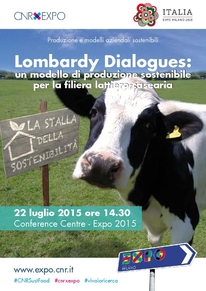Lombardy Dialogues: Setting a model for a sustainable dairy chain

Coordinator: Diego Breviario
Institute of Agricultural Biology and Biotechnology (IBBA)
INTERVIEW TO DIEGO BREVIARIO
What kind of event are you organizing for EXPO ?
The main purpose is to provide a complete overview of the dairy chain, starting from the animal diet and ending with cheese production. We will propose and discuss several innovations that can be introduced at each key step.
What kind of innovation will you present ?
At first , we will talk about the animal diet that must be provided judiciously that is adequate for the actual need of the cow and this may depend form several factors including body mass, physiological state, number of pregnancies, milk yield and nutritional value. We should be concerned of avoiding an excess of nutrients that also causes a negative environmental impact with the release of an excess of gas and sewage. It will also be recommended to improved the nutraceutical value of the animal diet by adding species such as flax and hamp, rich of beneficial polyinsaturated fatty acids.
Besides the diet, which additional innovations will you be talking about ?
An healthy cow is the best producer. So care should be taken in preventing diseases and limiting stress conditions that may possibly arise in the intensive farming management. A new form of sustainable genetics must also be adopted by which selection is not only focused on production but must also consider animal robustness, fertility and disease resistance so that the abuse of antimicrobial drugs can also be avoided. Also , it is very important to develop diagnostic tools capable of monitoring the occurrence of diseases at their very beginning and suitable for the concomitant identification of multiple pathogens including those that are more aggressive.
How can you check the animal diet composition? I am thinking about the mad cow. Could it happen again?
Feed control is of primary importance and to this purpose, new and more sophisticated analyses should be carried out. Let's take the production of the parmesan cheese as an example. It requires the compliance with a specific disciplinary of production that defines a dual list of allowed or prohibited plant species. Cotton or rice should not be present, for instance. How can you actually checked it ? At the EXPO conference we will present a new genetic procedure , developed within the Feedcode project funded by the EC, by which the actual composition of the feed can be scrutinized so that the presence of allowed or prohibited plant species can be easily ascertained. At the present, the method is under a validation procedure so that it may become a reference for feed traceability. A similar method has been developed for recognition of animal species and this may turn out to be useful to avoid the occurrence of a highly undesirable second round of the mad cow disease.
What about the milk? It is its turn now
Milk has an important nutritional content mainly provided by fatty acids and proteins. Thanks to the activities of several proteases, mainly of bacterial origin, beneficial biopetides are produced that can positively contribute to bone mineralization and tooth enamel thickness maintenance. They can also contrast diabetes. In addition, it is currently developed a microbial approach that may favor the enrichment, in the mouth, of probiotic strains capable of contrasting the occurrence of dental caries caused by some type of oral streptococcus. All this is fine but , speaking about microbiology, it should be bear in mind that the first priority remains milk safety that is the assurance, verified by constantly developed practices and methods, of the absence of pathogens and strains that may introduce antibiotic resistance within the gut microbiota.
Will we really able to interfere with all these factors?
Yes, because by favoring the growth of the lactic bacteria we inhibit that of the pathogens while improving the aromatic and nutraceutical properties of the milk that are eventaully transferred to the cheese,
Therefore, can we enriched the milk at..... its very origin ?
Yes, if you, as original source, intend the milk collected before cheese making. The lactic bacteria can indeed contribute to reduce the level of cholesterol while augmenting that of beneficial, free or conjugated, poly unsaturated fatty acids as well as vitamins like tocopherols. All these beneficial molecules can efficiently contrast the occurrence of relevant diseases, first of all those that damage the cardio vascular system.
What will be the consequence on cheese quality ?
Cheese will benefit from both the nutritional and the nutraceutical sides. In addition new beneficial contribution may come from the development of probiotic microrganisms that may develop during the process of cheese making.
What else can be done to further implement the dairy chain?
Well, we have to handle the waste that is sewage and animal dejections. These can be conveniently send to bioreactors where, thanks to the anaerobic digestion, they will eventually produce biogas and fertilizers. The former can be transformed in thermal or mechanic energy that is further commuted in electricity, to be used for the farm needs. Fertilizers , obtained from the solid, undigested left over, are very rich in phosphorus and nitrogen. Because of this, they are successfully employed to fertilize the soil contributing to reinforced its texture with beneficial effects on crop productivity. Basically, with such model, productivity runs in circle with the waste that ultimately concur to forage and cheese production.
How far are we from such a model ?
Well, all the things we have been talking about are in place. Milk enriched in omega3 fatty acids rather than CLA ( conjugated linoleic acid) is currently produced. The studies on the bovine genome are providing the scientific breakthroughs required for selection programs based on sustainable genetics. The main objective is to put all these things together and make it becomes the routine for any farm. We, at CNR are also engaged in such a commitment. In fact, making use of different experimental groups of goats, we are producing cheese with low colesterol and high CLA. This is achieved by providing hemp and flax to the diet thus increasing the amount of beneficial poly unsaturated fatty acids. In addition we increase the nutraceutical value of the cheese by adding to the milk lactic bacteria previously isolated ,selected and characterized for their metabolic features.
What is missing ?
The organization and the determination of putting all the different pieces together that is precision feeding, with a higher level of control about the composition and the amount of the diet, sustainable genetics, for the selection of wider range of characters, new diagnostic tools that allow the fast and prompt identification of pathogens, lactic bacterial strain selection to be used for increasing nutraceutical value and sewage recycling to produce energy. Italy is one of the major European milk producer with a large and prestigious cheese production, appreciated all over the world. It is a treasure that must be protected and further enriched to maintain the leadership in this relevant economical sector.
IN COLLABORATION WITH:
Università degli studi di Brescia
Università degli Studi di Milano
Victorian Department of Environment and Primary Industries
Parco Tecnologico Padano
Istituto Zooprofilattico Sperimentale della Lombardia e dell'Emilia Romagna
Institute of Food Research UK
Consorzio del Parmigiano Reggiano
Sacco Srl
FAI Farms Ltd
Università Cattolica del Sacro Cuore
Istituto di Biologia e Biotecnologia Agraria
Istituto per lo Studio delle Macromolecole
Istituto di Scienze delle Produzioni Alimentari








